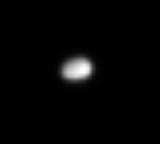Polydeuces (moon)
|
Saturn's moon Polydeuces | |
| Discovery | |
|---|---|
| Discovered by | Cassini Imaging Science Team |
| Discovery date | October 24, 2004 |
| Designations | |
| Pronunciation | /ˌpɒlᵻˈdjuːsiːz/ POL-i-DEW-seez |
|
Saturn XXXIV (34) S/2004 S5 | |
| Orbital characteristics [1] | |
| 377,396 km [lower-alpha 1] | |
| Eccentricity | 0.0192 [1] |
| 2.736915 d [lower-alpha 1] | |
| Inclination | 0.1774 ± 0.0015° [1] |
| Satellite of | Saturn |
| Physical characteristics | |
| Dimensions | 3 × 2.5 × 2 km[2] |
Mean radius | 1.3 ± 0.4 km[2] |
| Mass | 1–5 ×1013 kg [lower-alpha 2] |
| assumed synchronous | |
|
| |
Polydeuces, or Saturn XXXIV (34), is a small natural satellite of Saturn that is co-orbital with the moon Dione and librates around its trailing Lagrangian point (L5). Its diameter is estimated to be 2–3 km.[2] It is pronounced /ˌpɒlᵻˈdjuːsiːz/ POL-i-DEW-seez; Greek: Πολυδεύκης. Dione's other co-orbital moon is Helene, which is bigger and located at the leading L4 point.[3]
Polydeuces was discovered by the Cassini Imaging Team on October 24, 2004,[4] in images taken on October 21, 2004,[5][6] and given the temporary designation S/2004 S 5. Subsequent searches of earlier Cassini imaging showed it in images as far back as April 9, 2004.[4] Of the four known Lagrangian co-orbitals in the Saturn system ('trojan moon'), Polydeuces wanders the farthest from its Lagrangian point: its distance behind Dione varies from 33.9° to 91.4° with a period of 790.931 days (for comparison, L5 trails Dione by 60°).[1] Polydeuces's libration is large enough that it takes on some qualities of a tadpole orbit, as evidenced by the clear asymmetry between excursions towards and away from Dione. In the course of one such cycle, Polydeuces's orbital radius also varies by about ± 7660 km with respect to Dione's.[4]
The name Polydeuces was approved by the IAU Working Group on Planetary System Nomenclature on January 21, 2005.[7] In Greek mythology, Polydeuces is another name for Pollux, twin brother of Castor, son of Zeus and Leda.
Due to gravitational interactions with Dione, its surface may be in hydrostatic equilibrium but not its interior, similar to Methone being in hydrostatic equilibrium due to interactions with Mimas.
See also
Notes
References
- 1 2 3 4 Spitale Jacobson et al. 2006.
- 1 2 3 Thomas, P. C. (July 2010). "Sizes, shapes, and derived properties of the saturnian satellites after the Cassini nominal mission" (PDF). Icarus. 208 (1): 395–401. Bibcode:2010Icar..208..395T. doi:10.1016/j.icarus.2010.01.025.
- ↑ Patrick Moore, Robin Rees - Patrick Moore's Data Book of Astronomy (2011) - Page 214
- 1 2 3 Murray Cooper et al. 2005.
- ↑ Porco Baker et al. 2005.
- ↑ IAUC 8432.
- ↑ IAUC 8471.
Further reading
- Green, Daniel W. E. (November 8, 2004). "Satellites and Rings of Saturn" (discovery). IAU Circular. 8432. Retrieved 2011-12-31.
- Green, Daniel W. E. (January 21, 2005). "Satellites of Saturn" (naming the moon). IAU Circular. 8471. Retrieved 2011-12-31.
- Murray, C. D.; Cooper, N. J.; Evans, M. W.; Beurle, K. (December 1, 2005). "S/2004 S 5: A new co-orbital companion for Dione". Icarus. 179 (1): 222–234. Bibcode:2005Icar..179..222M. doi:10.1016/j.icarus.2005.06.009.
- Porco, C. C.; Baker, E.; Barbara, J.; Beurle, K.; Brahic, A.; Burns, J. A.; Charnoz, S.; Cooper, N.; Dawson, D. D.; Del Genio, A. D.; Denk, T.; Dones, L.; Dyudina, U.; Evans, M. W.; Giese, B.; Grazier, K.; Helfenstein, P.; Ingersoll, A. P.; Jacobson, R. A.; Johnson, T. V.; McEwen, A.; Murray, C. D.; Neukum, G.; Owen, W. M.; Perry, J.; Roatsch, T.; Spitale, J.; Squyres, S.; Thomas, P.; Tiscareno, M. (February 25, 2005). "Cassini Imaging Science: Initial Results on Saturn's Rings and Small Satellites". Science. 307 (5713): 1226–1236. doi:10.1126/science.1108056. PMID 15731439.
- Spitale, J. N.; Jacobson, R. A.; Porco, C. C.; Owen, W. M., Jr. (2006). "The orbits of Saturn's small satellites derived from combined historic and Cassini imaging observations" (PDF). The Astronomical Journal. 132 (2): 692–710. Bibcode:2006AJ....132..692S. doi:10.1086/505206.
External links
- Polydeuces Profile by NASA's Solar System Exploration
- IAU Working Group on Planetary System Nomenclature
- Cassini news release on ring and moon discoveries, via Spaceflight Now (February 24, 2005)
